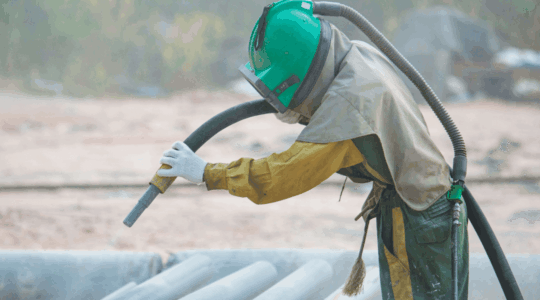Loss Control
5 Strategies for Reducing Workers’ Compensation Costs
A strong safety program can yield significant savings by reducing injuries and illnesses.
July 24, 2025
When a company experiences significant increases in workers’ compensation costs, it usually triggers internal activities aimed at reducing insurance costs and spending. The key to spending fewer dollars is more than just stopping a few accidents; it is having a sound safety program designed to continuously improve the risk profile. This is where a safety program can yield significant savings by reducing injuries and illnesses, saving workers’ compensation dollars.
Risk Profile Improvement
There are five elementary steps to improving the risk profile, which include having a well-rounded safety program that produces a safe work environment, achieves OSHA compliance, reduces accidents, and ultimately reduces workers’ compensation costs. These include the following:
- Develop safety and health programs.
- Integrate those programs into the daily operations.
- Investigate all injuries and illnesses.
- Provide training to develop safety competence in all employees.
- Regularly audit your programs and work areas to stimulate continuous improvement.
Develop Safety and Health Programs
Many incidents stem from poorly developed or poorly implemented safety and health programs. For example, failure to keep walking and working surfaces clear may result in slips or trips. Not using personal protective equipment may result in excessive lacerations. Poor lifting techniques can result in strains.
Many OSHA standards require a written program to be developed and communicated to employees. Experience shows that companies with thoroughly developed OSHA-compliant programs reduce their risk profile and, therefore, have fewer accidents, more productive employees and lower workers’ compensation costs.
Integrate Programs into Daily Operations
Policies alone won’t get results; a successful program must move from paper to practice. Putting a policy into practice requires a strategic plan clearly communicated to key participants, good execution of that plan based on developed competencies and a culture that inspires and rewards people to do their best.
When developing any business initiative, there must be an emphasis on frontline supervisors and helping them succeed. Every experienced businessperson knows that any new program—safety, quality or anything else—lives and dies with the frontline supervisor. If the frontline supervisor knows the program and wants to make it happen, the program succeeds; if not, it is a source of constant struggle and an endless drain on resources and energies. Providing supervisors with knowledge and skills through training is critical to the success of any program.
A solid safety and health program integrated into the daily operation and led by competent supervisors is just the beginning. Successful safety and health programs focus on being proactive instead of always reacting to issues. Incident investigations provide an excellent source of information on real or potential issues present in the workplace.
Investigate All Injuries and Illnesses
Workers’ compensation is designed to recompense employees for injuries or illnesses they suffer in the course of their employment. This should not come as a surprise, but increasing numbers of claims drive up workers’ compensation costs. To reduce those costs, you must reduce your accidents, and the ability to reduce accidents is significantly enhanced when those accidents are thoroughly investigated instead of simply being reported.
Incident reports are historical records that only cite facts, while incident investigations go deeper to find the root cause and make improvements. Businesses that stop rising workers’ compensation costs have an effective incident investigation process that discovers the root cause of the problem. Unless the root cause is discovered, recommendations for improvement will remain fruitless. Again, training proves beneficial because a supervisor skilled in incident analysis is a better problem solver for all production-related issues, not just safety.
All incidents should be investigated to find out what went wrong and why. Some may suggest that investigating every accident is a bit over the top, and only those that incur significant costs are worthy of scrutiny. But ask yourself this question: If you only investigated serious quality concerns instead of every little deviation, would your quality program still be effective? Companies with solid quality programs investigate and resolve every deviation from quality standards.
If your emphasis is only on those incidents that must be recorded on the OSHA 300 log, you close your eyes to the biggest incident category: first aid-only incidents. Many companies get upset about recordables or lost-time accidents because of the significant costs involved, but they don’t realize that the small costs and high numbers of first aid-only incidents add up.
Training and Auditing for Continuous Improvement
The final steps focus on training and auditing your program for continuous improvement. Training plays a significant role in increasing safety and reducing workers’ compensation costs. The goal of training is to develop competent people who have the knowledge, skill and understanding to perform assigned job responsibilities. More than anything else, competence will improve all aspects of your business and drive down costs. Supervisors must have the knowledge and ability to integrate every safety and health program into their specific areas of responsibility. Every employee must know what is expected of them when it comes to implementing safe work procedures.
Once the programs are developed and implemented, they must be reviewed regularly to ensure they are still relevant and effective. This might require a significant change in how you manage your safety program. However, it may be time to make this leap if your workers' compensation rates are high.
Tangible Benefits
Having a sound safety program yields many benefits, including the following:
- Studies indicate there is a return on investment and that companies see direct bottom-line benefits with a properly designed, implemented and integrated safety and health program.
- A competency-based safety and health program lowers incidents, which lowers the risk profile, which then lowers workers’ compensation costs. When incidents occur, a competency-based safety program thoroughly evaluates the issue, finds the root cause to prevent reoccurrence, and provides a workplace free from recognized hazards.
- A safer workplace creates better morale and improves employee retention. Auditing keeps your programs fresh and effective and drives continuous improvement.
- A competency-based program produces people who are fully engaged in every aspect of their job and are satisfied and fulfilled, producing high-quality goods and services.
How Can We Assist You?
At Hylant, we are committed to helping you establish a strong safety program that minimizes your workers’ compensation exposures. Contact us today to learn more about our OSHA compliance, safety program, and accident investigation tools and resources.
Related Reading: Ensuring Work Zone Safety for Commercial Drivers
The above information does not constitute advice. Always contact your insurance broker or trusted advisor for insurance-related questions.


